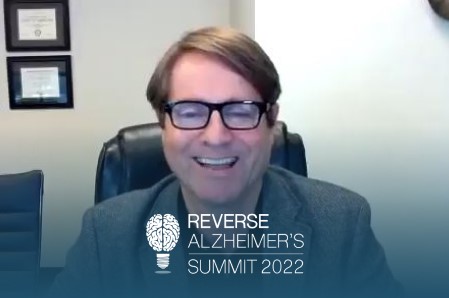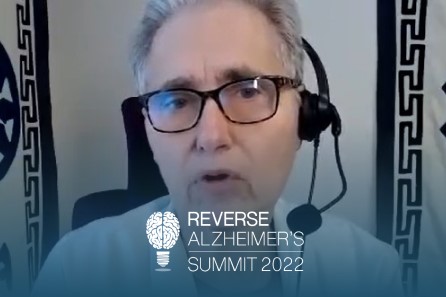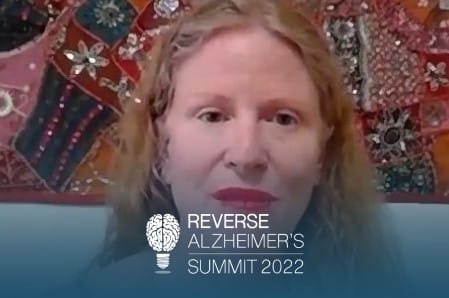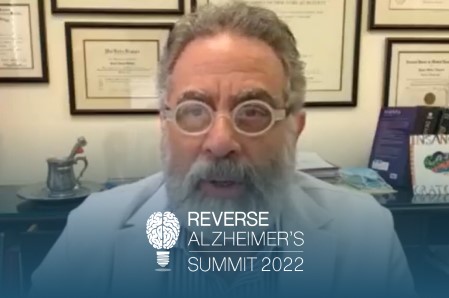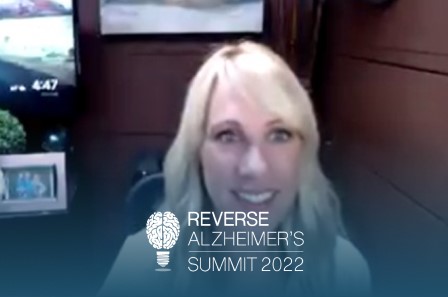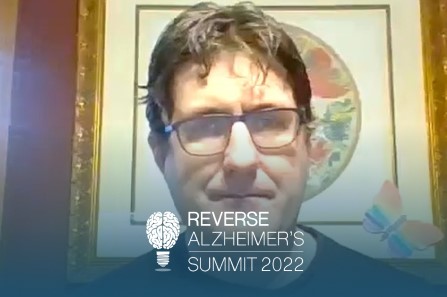Join the discussion below

Dr. Heather Sandison is the founder of Solcere Health Clinic and Marama, the first residential care facility for the elderly of its kind. At Solcere, Dr. Sandison and her team of doctors and health coaches focus primarily on supporting patients looking to optimize cognitive function, prevent mental decline, and reverse... Read More

Elizabeth Seymour, MD is a family and functional medicine physician who joined the staff of the Environmental Health Center in 2015. She learned, witnessed, employed and experienced the techniques and knowledge of Dr. Rea as together they examined patients. Dr. Seymour earned her B.S. in Biology at Texas Woman’s University... Read More
- How to know if mycotoxins are an issue for your brain.
- How to access testing; What does it mean and what to do next.
- How do we know when are done treating mycotoxins.
Heather Sandison, N.D.
Welcome to this episode of the Reverse Alzheimer’s Summit. I’m your host, Dr. Heather Sandison, and I’m so pleased to have Dr. Elizabeth Seymour, MD here today. She’s a family and functional medicine physician who joined the staff of the Environmental Health Center in 2015. She learned, witnessed, employed, and experienced the techniques and knowledge of the legend, Dr. Bill Ray, together, as they examined patients. She’s now a clinical consultant for patients and providers looking to better understand the results of their RealTime lab reports. I extensively use the RealTime Labs here in my office, and we’ve talked to a number of experts throughout the summit, about what it means to have mold and mycotoxins illness. And she’s gonna help us connect the dots about how we can get the benefit of this testing. She’s also a member of the American Academy of Environmental Medicine, the Association of American Physicians and Surgeons, the Texas Medical Association, and the American Academy of Family Physicians, as well as the Texas Academy of Family Physicians and the Dallas County Medical Society. So she’s very active, very involved, and she has been certified and trained by the Institute for functional medicine. So I’m absolutely delighted to have her here today. Welcome, Dr. Seymour.
Elizabeth Seymour M.D.
Thank you for having me.
Heather Sandison, N.D.
So first let’s start with just the basics. What is mold? What is a mycotoxin? How are they the same? How are they different? What are these things?
Elizabeth Seymour M.D.
Sure. So molds are part of the fungi or fungus family. And there’s many different types of funguses, and molds are one of those that can be produced. It’s grown on foods if food starts to spoil. It’s in your environment, especially in humid areas, or if there’s water and moisture, there’s gonna be an increased risk of mold growth. So it’s a natural thing that has been a part of our world. It helps with decomposition and decomposing things. And when you’re in a forest and you’ve got soil and you’ve got moss and all different things and mushrooms grow, that is another type of fungus. So there’s mold everywhere. But the concern we have is the different types of molds can produce something called a mycotoxin. And I’m sure you’ve learned about this during this educational session, mycotoxins can be very detrimental to human health. I always tell patients they can kill a horse, they can hurt a dog, and they can definitely damage and hurt a human being.
Heather Sandison, N.D.
Yeah. So what are some of the ways they do that? What do patients experience when they are being exposed to toxic molds or mycotoxins?
Elizabeth Seymour M.D.
Oh, there’s a list of symptoms that patients can have. Now, what we’ll commonly see, the most conventional physicians will think of mold and be synonymous with an allergy. And so, I always say, it’s like the Zyrtec commercial. If you get coughy, wheezy, sneezy, rashy, itchy, watery, congested, that is your typical zone of either your chest or your neck, or your head, or your sinuses, or your nose, or your ears or your throat, that is the Zyrtec commercial of symptoms. Most patients think of that and doctors think of that as allergies. So obviously, patients can have an allergy to mold. The thing that we get worried about is, when patients are living in a moldy environment or working in a moldy environment, exposed to a mold, number one, what type of mold is that? How much of that is in their environment? And is that mold potentially something that could make a mycotoxin? And that’s the toxic effect. We’re worried about mycotoxins, because you can’t see mycotoxins, they’re nanoparticles.
You can see mold growing on a wall, you can smell mildew and musky odors, but mycotoxins, you can’t see. These can be inhaled. They can be ingested. They can come through your skin. And so there are multiple symptoms that patients have, not just allergies. Now, if you get a lot of sinus infections, you have to go get your Z-Paks or your antibiotics or your steroid shots. If it goes into your chest and you get bronchitis, then people just think, “Oh, I just got a bacterial infection.” And that can be related to the different types of ENT problems that occur with mold allergies and mycotoxins. But mycotoxins, what I’ve figured and realized as a practitioner is that many symptoms, the most common ones are chronic fatigue, fibromyalgia. Fibromyalgia, it’s all these conditions that are idiopathic. There is no true clinical tests that can be done that says, “This is why you have fibromyalgia. This is why you have brain fog. This is why you are depressed. This is why you have chronic fatigue.” They’ll do a lot of tests to rule things out.
You’re not anemic. You don’t have sleep apnea, your thyroids considered normal and okay. So they don’t know why people have chronic fatigue, but there are a list of symptoms, multiple symptoms. Some people have GI problems. Some people have heart racing and they may have autonomic nervous system dysfunction. They may have neurological symptoms, not just headache, and, “I can’t think clearly. And I’m 30 years old and I feel like I’m 100 with dementia and Alzheimer’s.” They have lots of different cognitive impairments that can occur. Some may have neuropathies, numbness and tingling, and they’re not diabetic, and they don’t have a low B vitamin level, and they’ve had all these different types of diagnostic tests and everything looks normal. So it’s kind of this idiopathic. We don’t really know what causes it, but we know that they’re having clinical symptoms. We can try a bunch of medications to help with those symptoms, but really we have to peel back the layer of the onion and figure out what is it that’s causing a lot of these symptoms, and how can that be related to mold and mycotoxin exposure.
Heather Sandison, N.D.
I’m just so curious. I had the privilege of shadowing Dr. Bill Ray in Dallas for a week. And he’s since passed away, which was a loss to the community. He literally wrote the books. He wrote some of the textbooks around environmental medicine and was a pioneer in this space in the 70s, I believe, 80s, 90s and then until really recently, and worked until the very end of his life. And you had an opportunity to work with him for several years. I’m curious because mycotoxins are kind of newer. We’ve been talking about them more in the environmental medicine community more recently, whereas he was talking a lot about food allergies, maybe chemicals in the environment having metals, certainly, but these mycotoxins are new. I’m curious what your thoughts are, of course, you as a physician, but also what Dr. Ray’s thoughts were, having had this perspective of decades of environmental toxicity in patients.
Elizabeth Seymour M.D.
Of course. Well, there weren’t a lot of good tests to really, again, assess for it. Now, patients could say, “I had a pipe burst” or, “I had a flood”, or, “I lived in the armpit of Texas and where it’s humid.” Or, “I lived below sea level in New Orleans.” I mean, there’s different environments in different locations geographically where you’re gonna be an increased risk for mold. And then these patients would come in and see him. And trust me, they’ve seen 50 plus doctors, They’d seen all the specialists. They’ve paid tens of thousands, if not hundreds of thousands of dollars on treatment and they’re disheartened, they’re frustrated they’re not getting better. And so he could always tell, just based on his study and his learning from his mentors, that it could be mold. Now, the way that we would test it and confirm that you have, number one, a sensitivity to mold or an allergy to mold, and that you need to avoid, it would be our skin testing.
And so, he would rightfully, so he could skin test foods and desensitize to foods, if there were certain foods that you couldn’t avoid. He would desensitize to different pollens, grasses, weeds, and trees, obvious things, dogs, and cats. He could desensitize to molds. And then he started getting into more commonplace things like chemical testing. So these patients that have chemical sensitivity, anything in environmental medicine, your foundation is gonna be avoidance. But if you’re a human being and you have food allergies and you come to see me, and you say, “I’m only eating three foods because I have diarrhea and vomit, and react to every other food that I eat”, then I will always tell them, “Houston, we have a problem. When you’re a human being, and what do you need to survive? Oxygen, water, and food. That’s what you need to survive. And if you don’t have the food, we’re not gonna live very long. Okay?” So that’s really where he came in and started testing those different types of things. And the other issue was there weren’t labs out there that were available to test for mycotoxin.
So RealTime Lab, I believe it opened in either 2003 or 2007, and actually worked hand in hand with Dr. Ray on developing the test and assessing for mycotoxins. There are other labs out there now that do that, but they were really at the forefront and the front runners of how do you test for this. So, obviously with Alzheimer’s disease, there are some newer blood tests that could possibly be coming out that could be a diagnostic test for Alzheimer’s, and that would change things dramatically, because really what Dr. Ray and what most physicians are going off of is clinical diagnosis. Same for Parkinson’s. We really can’t diagnose these conditions unless they’re postmortem. I mean, at least that’s how I was trained. And when I was in medical school, I don’t really remember anything about mold, and maybe that’s just ’cause I was so busy and inundated with pharmacology and pathology and microbiology. But I do remember fungal balls in the lung and thinking about aspergillosis and different types of conditions, but no one, in family medicine and the couple of hours of nutrition that I had, ever talked about mold. And when you think of mold, you just think of allergies. I don’t even think I’d ever heard the word mycotoxin even before.
So it was a real honor to be able to work with Dr. Ray, and have him as my mentor and be side by side with him, patient by patient. And I mean, I just learned basically by osmosis, I was thrown into the fire, and I’m sitting there writing and listening and reading. I mean, his books, oh my gosh. The medical textbooks that he wrote were phenomenal. It was a divine opportunity to work with him and to learn with him. And then, unfortunately he passed in 2018 unexpectedly, but he was 83 years old and I got the opportunity to take over and become lab director, and I just wanna continue his legacy, because it was proven to me how many patients he helped. And it was a very emotional thing because he literally saved tens of thousands of lives and changed people’s lives by helping them be educated and informed to test, to objectively confirm, to help with detoxification and to make them feel better, and live longer and have a better quality of life. So it was an honor to work with him.
Heather Sandison, N.D.
What a unique and special opportunity. And then he helped to develop the RealTime Lab, he was working with the team over there to create this assay so that clinicians would have the tools that they needed to determine whether or not mycotoxins might be a problem for the patient in front of them. I mean, I have done this this morning. I have had this conversation with a patient reviewing their RealTime Lab results. So, tell me a little bit about how you run this test for mycotoxins at RealTime.
Elizabeth Seymour M.D.
Sure. So basically, it’s a urine specimen. So, when you get your kit, they can ship it to you or your physician can order, it’s a kit that will be given to a patient. You will urinate in the cup, and then you fill out your name and your date of birth and all the contact information, your insurance information, and then you send it back to the lab. So what we’re testing is for its parts per billion. So, other labs, I’m not sure if they actually, most of the labs don’t use ELISA testing, but we do a ELISA testing. It’s a greater sensitivity and specificity when you’re testing parts per billion. It’s a semi quantitative test, and it’ll provide practitioners with either a positive or a negative answer, or an equivocal, and it gives you an numerical value. And over time, if you repeat that test in three months or six months, or once a year, you kind of get a baseline and then you wanna look at that in the future. And whatever you do to help detoxify your patient and make them aware that, are they living and working in a clean environment or are they getting exposed to mold, you can track that over time with linear values to see whether that’s going up or going down.
Heather Sandison, N.D.
Yeah. I find it very, very helpful. And then, many of our listeners are gonna be wondering, “Okay, if I know I have mycotoxins, how do I get rid of them?”
Elizabeth Seymour M.D.
Sure. So that’s a loaded statement. So obviously, when you have a toxin, you need to detox. And I always tell patients this is not an alcohol and a drug detox. When I’m a physician and I hear the word, “Oh, that person’s detoxing”, or, “They’re going to detox”, I think of alcohol and drugs, which is another form of treatment, obviously for addicts. Every day, the human body physiologically detoxifies. That is through breathing, that is through hair and nail growth, that is through skin sloughing off, it’s through urination, it’s through defecation, it’s through sweating. So, how do you amplify those things? And generally what I’ll tell patients, there’s lots of ways that you detoxify. I give my patients five kind of categories. The first is supplementation. And so there’s different supplements such as binders and glutathione and certain medications that you can use to help with binding toxins and essentially getting them out. So you would think about, if you had a patient that went into the ER that tried to commit suicide and they overdosed on Tylenol, what’s the first thing they do? They put a tube down their stomach and they fill it up with charcoal, because they want it to absorb the toxin so that it’s not absorbed through their stomach and into their bloodstream that their liver has to process, that can be toxic to their liver and kidneys, and brain, and multiple different organs. So, like I said, there’s different binders that we may recommend. And then, the other is IV nutrition.
A lot of these patients have GI issues, where they don’t have the stomach acid, they’re on proton pump inhibitors and different antacid H2 blockers, and they can’t physically break down their food, their nutrients properly. So, it could be that. They can’t assimilate. They can’t absorb it. And so, IV nutrition really bypasses the gut, and it’s more effective to me. We use lots of different IV nutrition. You can use vitamin C, glutathione, minerals, B complex, magnesium, taurine, sodium bicarb, I mean, alpha-lipoic acid, phosphatidylcholine, NAD, there’s multiple IVs that you can give someone, that I know as a physician, that this gets directly into the cells. It bypasses the gut. We don’t have to worry about your gut problems and absorbing it, and patients feel better. But not everybody has a provider that does IVs, not everybody has access to those types of IV nutritions. Some people may have allergies to those types of IV nutritions that they’re not aware of, or it may be too much too fast and they feel sick when they detoxify. There’s a lot of different things your doctor has to be aware of when they’re giving those types of nutritions.
How how often do I get it? How much do I get? Is it a slow drip? Is it a push? They’re expensive. Not everybody has a nursing friend that can do these at home, and we don’t recommend that you do these at home. We recommend that you do them in a doctor’s office where you’re monitored, in case of any adverse reaction. So, IV nutrition is a common place, especially for people that may have gut issues or don’t feel like they’re responding to oral supplements. The next one we recommend are more physiologic things, not oral pills and supplements, because I know with functional medicine, we recommend a ton of supplements, a ton of pills and liquids and drops and things like that. And a lot of my patients, I would say, get pilled out. It’s not that these supplements don’t work, but patients are going to all the different pharmacies and stores, and online and going, “I can’t sleep. Well, I tried melatonin and I tried this, and I tried that.” And they’re grasping for things that are over-the-counter, that are usually cheaper than medications to help treat a symptom, and they’re not figuring out why they have this symptom. And sometimes these things obviously do work. I know if I take a lot of melatonin, I sleep like a baby.
So it’s not that we’re anti-supplement, it’s just sometimes the supplements have their limitations. So the next things, besides the IV nutrition and the oral supplements, we’ll recommend is to sweat. Now, I’m from Texas, and I love this time of year. It’s almost June. It gets 110 plus degrees. And you just go outside and you start sweating. There’s a lot of patients that’ll say, “I don’t sweat well.” And that’s because they have autonomic nervous system dysfunction. I can’t sit here and go, “Okay, body, start sweating.” There has to be something where I’m either running and exercising and my heart rate’s going up, or it’s 110 degrees outside, and I walk outside and I start sweating. So, if those patients that have chronic fatigue, they have fibromyalgia and their muscles hurt, they have osteoarthritis and their knees and hips don’t work and their back aches, they’re depressed and they can’t pull themselves out of bed, you can sit there all day, and I’ve done it for the last 13 years as a family medicine doctor said, you need to go exercise. You need to go exercise. And they just can’t, okay? So we have to meet them in the middle and meet them where they’re at.
Sometimes I’ll tell them to start saunaing. There’s clubs, there’s spas, there’s gym memberships, there’s hot works, there’s saunas you can purchase yourself and build and put in your home or your bathroom. So there’s all different ways that you can sweat, but we wanna start getting people to start sweating. So that’s why we recommend sauna because it’s a passive form. You literally sit there. You don’t have to do anything, just sit in the heat and, over time, you’re gonna start to sweat, and you’re gonna start to release these toxins. When people get done, I say go take a shower. If you don’t have access to a shower, ’cause I don’t want your toxins to get reabsorbed within your skin. Your skin is like a veil. It may not look like it, and you can’t see through it, but it is an organ that absorbs toxins. And so if those toxins are sweated out and not wiped off or washed off, then you could potentially reabsorb those. So if you don’t have access to a shower, we’ll tell you to get a wipe, and wipe your body down with a wet wash cloth or some kind of wipe down. The next thing we’ll recommend is lymphatic massage. You can go get any kind of massage, but lymphatic massage is a specific form of a massage that is focusing on lymphatic flow. Those lymphatics flow along just like your blood vessels, along with them and your nervous system, and that is your major form of detoxification. If my son came home from school or daycare, and he kissed me and I got strep throat, I’m gonna have a sore throat.
I’m gonna look in the back of my throat, I’m gonna have these pest pockets, it’s gonna look disgusting. It’s gonna hurt. I’m gonna have fever. I’m gonna have a headache. And the number one thing that happens is these glands, right here in my neck, get big and swollen. And you don’t realize how much you spit every day and how much you swallow. So every time I’m swallowing, I’m going, “Oh my gosh, this hurts.” I go see my doctor, they say, “You need an antibiotic.” I may take it, I may not, but that’s your choice as a patient. And I know that these lymph nodes are swollen. And what they’re trying to do is clean out the toxins that can occur from bacteria. And just again, like a bacteria can produce a toxin, a mold can produce a toxin as well. So lymphatic massage is a specific form that we would recommend to help with getting lymphatic flow. The last thing that we would recommend, and a lot of people squirm in their seat and they don’t want to hear it and they’re uncomfortable, but it’s making sure that your bowels are working properly. If you have constipation, if you have five bowel movements a day, or 40, I mean, anything more than about one or two is probably not good and you’re probably not absorbing your nutrients. So what we’ll tell patients, and I always start with, Hippocrates was everyone’s first physician.
And he said, “Death begins in the colon.” So, you need to make sure that your colon is clean. So we would tell patients, if they’re scared of colonics or colon hydrotherapy, to start with enamas at home and make sure that their bowels are getting moved. But I prefer and recommend the full washout, as we call it. I don’t say that it’s a water hose on high in your bottom, it is a low flow. It’s a warm water. It’s not too hot, it’s not too cold. And you will literally feel the water, that should be filtered, move up your rectum into your sigmoid colon into your descending colon, and then you’re gonna be a human being. You’re gonna go, “Man, I got pressure, and I gotta go, number two.” And you’re gonna defecate out. And I always laugh and go, “Human beings really had no idea how full of it we really are.” And so it’s not just defecation, it’s not just having bowel movements, it is removing metabolic waste and buildup, it’s removing toxins, it’s removing biofilms. And I use that, and it really does work. And so again, most conventional doctors, we never learned about colon hydrotherapy, or colonics, we just learned about colonoscopies and diagnosing colon cancer, and biopsies and ulcerative colitis, and Crohn’s, and hemorrhoids, and anal fissures, and all these weird things that occur in your GI system.
So those are my five main things: oral supplements, IV nutrition, sauna, lymphatic massage, and colon hydrotherapy. But again, there are multiple things. There’s acupuncture, there’s ionic foot detox baths, there’s Epsom salt bath and soaks. There’s multiple ways to help you detoxify every day. And then the other is breathing, and we can go into meditation and deep breath and all those different techniques. But I always tell patients, bottom line, you can detoxify till the cows come home, foundationally, you need to make sure that your environment, work and home, is clean, because patients spend a lot of money, time and energy to detoxify these mycotoxins out. But when you go right back into a moldy environment and you’re unbeknownst or know that you’re being exposed to mycotoxins, you’re the hamster on a wheel, you’re putting a lot of effort, energy and money and time into it, but you’re not getting very far because you’re going back into a toxic environment. So, that is foundational, is to have a clean environment, and again, that’s a loaded statement. There’s a lot of education and learning on what does it mean to have a clean environment. But if you do suspect mold, if you do smell mold, we recommend you test for it in your urine. And if you have mycotoxins, then there is an answer that is very objective that will tell you you’ve been exposed to mold sometime, and you have the toxins in your body and they’re coming out in your urine, and you need to obviously detoxify those out.
Heather Sandison, N.D.
So how do people access this testing? Do they need to go to a functional medicine doctor who already has relationship with RealTime? Or is there another way that they can get access to this?
Elizabeth Seymour M.D.
Of course. So, yes, if you’re a physician, a chiropractor, some type of provider, nurse practitioner, nutritionist, you can get an account set up with RealTime Lab and get the testing kits sent to your office and you just distribute them to the patients. And again, the talk with RealTime Lab about how much does it cost and insurance coverage and all those things, there is also another option called a DAT, a direct access test called DAT, to us here. And there are certain states that allow patients to go online and deal directly from consumer to lab, where they can order the test. So if there’s a patient in, okay, I’ll just use Texas as an example. If you don’t have a physician that will order this test for you, or that is open to ordering it, then you can go online directly and we can send the test to you. Now that’s state-specific, I don’t have every list of which states, but there’s 20 plus states that allow you to do direct access testing.
Heather Sandison, N.D.
And I will say that, from my experience working with RealTime Labs, because I run a number of their tests every month, I’ve had patients in San Diego County who have called RealTime and said, “Hey, is there a doctor near me who can provide me with this test?” And they say, “Yes, you can go see Dr. Sandison.” And so even just reaching out to them and asking who in your neighborhood and your county already has a relationship with RealTime can be a shortcut to getting access, if you don’t have that direct access because your state doesn’t allow that.
Elizabeth Seymour M.D.
Absolutely. Correct.
Heather Sandison, N.D.
And then what about internationally? I have had patients who are international patients, who’ve maybe flown to San Diego, we’ve figured out that they have mycotoxins in their home. And then we wanna be able to reassess, but they’re not ready to fly back. I usually am retesting mycotoxins every 12 weeks or so. And so this is pretty regularly, and I would love to have access for international patients. What is that like?
Elizabeth Seymour M.D.
Well, that’s something that we’re working on. Our marketing director is partnering with Canada, with Australia, with Europe, with South America, because we’re in the world. We know that viruses are in the world, bacteria are in the world, and mold and mycotoxins and chemicals, there’s a lot of things in the world that you’re exposed to that can affect your health. So, if you will call RealTime Lab, if you’re a specific patient out of the United States, or if you’re a lab vendor, or someone that needs to get these testing kits, we can work with you on trying to get an account set up and ship them to you going through customs and all those other things, and regulatory. So we’re working on our international protocols to make sure that everyone in the world knows that they can have access to these types of tests, not just United States patients.
Heather Sandison, N.D.
Fantastic. That’s so helpful. And then, how do you know when you’re done?
Elizabeth Seymour M.D.
Well, So I get these questions a lot. “Can you quantify for me how long I’ve had mycotoxins in my body?” And we can’t. That’s not what we test here. We’re either gonna give you a present, a not present, or an equivocal lab result that will tell you what types of mycotoxins you have, associate what some common conditions and symptoms may occur with that exposure of mycotoxins, what types of molds produce those types of mycotoxins. And then the other testing, besides the urine tests that we do for mycotoxins is a EMMA, an Environmental Mold and Mycotoxin Assessment. It’s basically a Q-tip dust swab that you can swab your environment and send it to us and we will test for both molds and mycotoxins and see is there a correlation with that type of test, in addition to the urine mycotoxin test. For instance, if something came back with stachybotrys on the EMMA swab, which is a mold, and then the EMMA swab had a mycotoxin test that also showed trichothecene mycotoxin, and then you test your urine and it comes back with trichothecene mycotoxin, that’s where you’re clinically gonna correlate that, “Looks like you had stachybotrys in your washroom. And it also had trichothecene on the dust swab, and now your urine shows trichothecene.” So that’s how you clinically will correlate those types of things. I’m sorry. repeat your question, ’cause I wanna make sure I answered it in entirety.
Heather Sandison, N.D.
Yeah, I’m curious. I certainly get this question from a lot of patients. It’s like, how do we know we’re done? So, when the test is negative, does that mean that we’re done? Or do we still need to be concerned?
Elizabeth Seymour M.D.
So, that’s why I was saying, I’m sorry I got sidetracked, on how long has these been in? So they could be in your body for five hours, five months, 15 months, years, decades, I don’t know how to answer that question. We don’t have anything that quantifies how long has it been or how long have you been exposed, or how long have these toxins been in your body. But the other thing, that I recommend, they always ask is, “Well, how often do I test this?” So you get your first test, which is a baseline, and you see if it’s positive or negative. If it is positive or present, then again, you’ve got a toxin issue, and that’s why we work on environment and detoxing. But I generally tell patients to go on about a three to six month detoxification protocol, get remediation, clean their house up, get it assessed, make sure that it’s not the workplace or wherever it is that they are, just make sure they have a safe environment, because if they don’t, then that’s that hamster on a wheel scenario that starts to occur. So once they have that, then they’ll usually recheck it in about three months or six months. Now, how do you come up with that number instead of just grasping it out of the air? In general, pathologist and and physiology will tell you that the average life cycle of a red blood cell is 90 days. So that’s how I come up with a minimum.
If you go through a three month detox and you’re in a clean environment and the life cycle of a red blood cell is 90 days, usually within that three month period, you should start to see that those values that are elevated, start to go down. These tests can add up and cost. A lot of patients spend a ton of money on testing and doctor’s visits and treatments. So, we have to be cost conscientious as well. And so sometimes I’ll say you may wanna do it every six months. But ideally, a baseline and then repeat it every three to six months. Sometimes you can do it annually, but really, what you wanna see is those values come to low or not present, because that’s how you’re gonna ultimately decrease your risk. You’ll get an immune response with these toxins, and that can lead to a whole bunch of other problems with your immune system, autoimmune disorders, infections, and just overall illness can occur. In short, it’s not an exact science, but if you understand the rationale of why we say three months, six months, that’s ideally why.
Heather Sandison, N.D.
And have you, in your practice, seen patients regain cognitive function after treating mycotoxin?
Elizabeth Seymour M.D.
Oh, absolutely. Yeah. So again, brain fog is not an ICD-10 diagnosis, but that’s what patients are gonna tell me and telling you is that, “I can’t think clearly.” When I have a 20 or 30 or 40-year-old that come in, and they will literally tell me, word-for-word, “I feel like I’m 90 years old and I have dementia.” They don’t have dementia at all, at least I can’t diagnose that yet. I don’t have any functional MRIs, SPECT brain scans, lumbar punctures, CAT scans, MRIs, blood tests that I can say, “Oh yeah, you for sure have dementia.” It’s kind of like Parkinson’s, these are clinical diagnosis. You’re not gonna diagnose someone on their first visit with Parkinson’s unless they have obvious cogwheel rigidity, masked facies, tremors, those types of things. It’s usually months or years or multiple visits before you can clinically diagnose it, ’cause there’s not a blood test to test for it. So, those are the things that we wanna look at and assess, and know exactly what they’re being exposed to, and then how do we detoxify that out.
Heather Sandison, N.D.
Fantastic. Well, it’s such a pleasure getting to understand a bit more, and I know this has been super valuable for our listeners, to understand a little bit more of the basics. We’ve been diving into the depths of mycotoxins and mold illness and toxic illness. And I think hearing other speakers validated through this, hearing that there’s similar approaches, there’s a system to it all, it doesn’t have to feel so overwhelming. And then in fact, you too have seen patients regain cognitive function, particularly younger patients. And that’s a big part of the message here, is that we wanna prevent Alzheimer’s disease, we wanna prevent that cognitive loss, and that the earlier we start, the more success we have. And yet I’ve seen patients who are older, who have diagnosed Alzheimer’s disease, who have mycotoxins that are contributing to that, and so getting rid of them is so beneficial and so helpful. And I’m so grateful to RealTime Lab for all of their support and for creating this tool that’s been just absolutely critical in my own clinical practice. So thank you, Dr. Seymour, for being here. It’s an absolute pleasure. I wanna make sure that our listeners know how to find out more about you and RealTime Labs.
Elizabeth Seymour M.D.
Sure. So, you can go online and just www.realtimelab.com. I’m available for consultations with clinicians. If you are first time ordering this test, and you don’t know how to relay it to a patient or what to do or where to start, I’m happy to help, hold your hand and walk you through how I approach patients. And then also, we have a nurse that helps with answering our patients questions, we get inundated with different questions. I’ll give you examples of where to go and who’s in your area and who may be able to help you. We’re doing our best to try and help educate and get an objective test that can confirm a lot of your symptoms. And when you detox those things out and you start to say, “My brain is back and my ADD is gone. And I can focus and my memory’s better, and I don’t forget things.” You, as the patient, will be convinced, I don’t have to convince you. When your health and your symptoms improve, that’s how you know, “Wow. This could have been mold and mycotoxins and allergy or sensitivity to it this whole time and I didn’t realize it.” And then myself, I am also a physician and a medical director at the Environmental Health Center. So, my website is www.ehcd.com. It’s the acronym for Environmental Health Center, Dallas. And then our phone number is 368-4132. You can, again, go online and get all our information and understand where we’re at, what we do. We do telemedicine consultations. We do telephone consultations, and we see people, obviously, in house. And we test and treat and diagnose, and just do everything we can to help them get better.
Heather Sandison, N.D.
So fantastic. Thank you so much for your time and expertise, sharing your wisdom with us today. It’s been a pleasure having you.
Elizabeth Seymour M.D.
All right. Thank you. I appreciate talking, and I hope everyone gets healthy and gets improved by all this education and relay of information. Thank you again.
Heather Sandison, N.D.
Thank you.
Downloads



